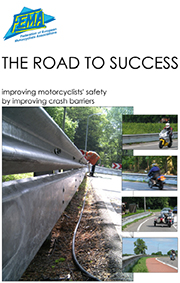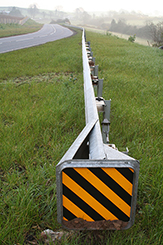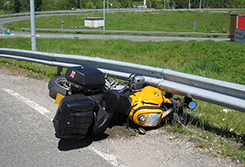FEMA Reports Progress – MEPs Support FEMA’s Guardrails Campaign
12th May 2010
 Last week Commissioner Siim Kallas responded in a letter to the FEMA President where he explained that the issue of the adoption of a European standard to include motorcyclists into the testing of safety barriers on the road, would fall under the responsibility of Commissioner Antonio Tajani who is responsible for the Industry and Entrepreneurship department. In his letter Kallas says: “I will inform him about the importance that this standard has for the safety of motorcyclists”.
Last week Commissioner Siim Kallas responded in a letter to the FEMA President where he explained that the issue of the adoption of a European standard to include motorcyclists into the testing of safety barriers on the road, would fall under the responsibility of Commissioner Antonio Tajani who is responsible for the Industry and Entrepreneurship department. In his letter Kallas says: “I will inform him about the importance that this standard has for the safety of motorcyclists”.
The final decision about the inclusion of motorcyclists into the testing requirements for guardrails will be taken in Prague on June 12th.
The Federation of European Motorcyclists Associations (FEMA) also reported in March 2010 that Dutch MEPs Corien Wortmann-Kool and Wim van de Camp are backing FEMA’s pledge for political action to put an end to dangerous crash barriers.
The two Members of the European Parliament have put their weight behind FEMA’s campaign, urging the European Commission to take action now.
FEMA says that, “After two decades of awareness campaigns and active national lobbying, products specifically dedicated to protecting sliding motorcyclists are now available on the market. However, the current European standard still does not include anything on motorcyclist protection. Some countries hide behind this and refuse to install more protective systems.”
CEN – the European Committee for Standardization, responsible for standards ranging from toys to fire extinguishers – is working on an improvement and produced an acceptable draft late last year. Now it must be accepted by two CEN committees, in March then June, before it becomes available all over Europe.
“We are at a very delicate stage now,” says Hugo Roebroeck, FEMA’s Campaigns Officer. “a similar draft was rejected in June last year because some CEN members wanted to tinker some more with it. We believe it’s not the good way to go: CEN should validate now an acceptable standard that protects riders, and then improve it later. We have already lost a year and they can’t delay this forever, the motorcycling community won’t accept it.”
 Following this first delay, Mrs. Wortmann-Kool asked the European Commission last year why nothing had been done to help the introduction of motorcyclist-friendly crash barriers. The Commission has an advisory position at CEN, and could help greatly by supporting the process, as it did in the past on other topics.
Following this first delay, Mrs. Wortmann-Kool asked the European Commission last year why nothing had been done to help the introduction of motorcyclist-friendly crash barriers. The Commission has an advisory position at CEN, and could help greatly by supporting the process, as it did in the past on other topics.
With the support of Mrs. Wortmann-Kool and her colleague Mr. van de Camp, FEMA wrote to Transport Commissioner Siim Kallas, urging the European executive to get involved.
Bernd Lange MEP, has also backed FEMA and called for the European Commission to support the process.
“We are confident that more Members of the European Parliament will back us,” Hugo adds. “Motorcyclists have worked hard for this. It will be a test for the new college of Commissioners, to see if they are serious about their plans for improving road safety – for everyone.”
Right To Ride says – We watch with interest on FEMAs progress and with the recent DOE Road Safety Strategy consultation in Northern Ireland which will consider provision of specific route treatments for popular motorcycle ‘runs’ such as motorcycle ‘friendly’ barriers and additional signing and the needs and vulnerability of motorcyclists when designing new roads and implementing safety measures on existing roads, we can only hope that consideration will be given to motorcycle friendly guardrails and the continued use of wirerope barriers.
For example Bikeguard (pdf 3.7mb) in the UK is fully tested to BS EN 1317 part 2 and fully approved by the Highways Agency for use on the UK trunk road network. (“HA Accepted EN1317 Compliant Road Restraint Systems”) as is Flexguard (pdf 1.1mb) and, Biker Safe (external website) has been tested to meet the standards EN1317 and UNE 135900 relating to vehicle and dummy post impact tests respectively.
 Bearing in mind Roads Service under the Department for Regional Development are responsible for roads in Northern Ireland.
Bearing in mind Roads Service under the Department for Regional Development are responsible for roads in Northern Ireland.
There are other issues for riders, as it would appear that the standard at present concentrates on riders who slide into barriers and does not include riders who are upright on impact, therefore excluding 50% of the problem.
While a new standard may be implemented, it is how this is implemented in the “real world” for motorcyclists to be taken into consideration.
This is because new road projects and the retro fitting of motorcycle friendly systems and in fact reviewing roadside restraint systems without protection, which have been already fitted, (not to mention the auditing of these systems regarding motorcycle safety), implies significant extra cost and acceptance by the European road authorities and in the case of Northern Ireland, our own Roads Service.
EuroRap – Barriers to Change: designing safe roads for motorcyclists – December 2008 pdf 2.4mb Annex 1: Dutch decision tree Page18/19
Of more importance is the issue of wire-rope barriers, that have been considered by motorcyclists as the most dangerous restraint system fitted on our roads, which seems to have been lost in the details.
FEMA website www.fema-online.eu
FEMA Survey
 In August 2009 FEMA (Federation of European Motorcyclists Associations) launched a wide European campaign which included an online question survey to gather individual testimonies from riders and relatives describing injuries suffered while hitting guardrail.
In August 2009 FEMA (Federation of European Motorcyclists Associations) launched a wide European campaign which included an online question survey to gather individual testimonies from riders and relatives describing injuries suffered while hitting guardrail.
FEMA said, “Faced with incomplete accident records, it is essential to gather as much data as possible in order to get a clear and accurate view of typical accident configurations, in order to elaborate a safe and adapted test standard for future barriers.”
However the survey has shortfalls, it only covers riders who slide into barriers and does not include riders who are upright on impact, therefore excluding 50% of the problem.
We await any report that may be produced.



Speak Your Mind